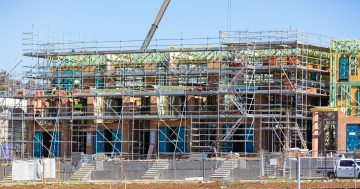
Commercial properties in industrial areas such as Fyshwick are performing strongly. Photo: File.
As inflation and interest rates play havoc with the nation’s residential property market, one industry division remains largely stable.
Civium director Andrew Smith said while the three main sectors of Canberra’s commercial property market were “performing at different levels”, the overall outlook was positive.
“The industrial market, which is mostly properties in the suburbs of Fyshwick, Mitchell and Hume, is performing really strongly with high investor and tenant demand,” he said.
“A lot of that is driven by high levels of construction and related activity taking place throughout the ACT right now.
“It is also linked to changes in the way manufacturers and retailers are getting their products to customers.”
Mr Smith said as the prevalence of online shopping skyrocketed to astronomical levels, fuelled by COVID-19-induced lockdowns and isolation, many retailers have opted to use properties in industrial zones as distribution centres rather than handling shipping or having customers pick up purchases from storefronts.
It’s a different picture for the second major commercial property market sector, the office building market – but again, the outlook is not as bleak as some might guess.
“This market is in a bit of a holding pattern, the primary reason being that there’s not a lot of tenant movement,” Mr Smith explained.
“That’s because a lot of businesses that used office space prior to COVID are assessing what they need from that perspective, driven of course by changes in work-from-home habits and requirements.
“These days if a business has 100 staff, it doesn’t necessarily follow that they have 100 desks. They might just have 60 or 70 which means if managed correctly, they can have a smaller footprint.”

Civium director Andrew Smith said some sectors of the commercial property market were performing outstandingly, while others were in a holding pattern but are likely to see high demand in 12 to 18 months when he predicts the economy will stabilise. Photo: Thomas Lucraft.
The other market is services and retail, which Mr Smith said tends to operate in places like Phillip or Belconnen. These continue to perform stably.
“Services, whether medical, vehicle repair, veterinarian or otherwise, are always in demand,” he said.
“Nearly all these changes are off the back of the pandemic; the flow-on effects of changes in our personal and work habits and our lifestyles.”
Unsurprisingly, the biggest impact “by a mile” on commercial property values has been interest rates.
“The commercial property investor generally buys to obtain a financial return on their investment. If the yield of the commercial property is lower than interest rates then they’re negatively geared. That doesn’t usually happen in commercial property,” Mr Smith said.
“Investors are looking to buy property at higher yields because borrowing costs are at least 3 per cent higher than 12 years ago.
“Once people see a levelling in interest rates, they’ll have confidence that they can predict their long-term expenses for a building.”
Mr Smith’s prediction for the market in the coming year is that values are unlikely to change significantly in either direction.
“I think we’ll remain in a bit of a holding pattern until the economy stabilises and interest rates flatten, which I think will be in 12 to 18 months,” he said.
“Then we’ll see high levels of demand from buyers across all sectors.”
In the meantime, market forces have left gaping opportunities for savvy investors.
“Opportunities lie where there are vacant properties which could be leased for higher rental rates than they previously have been,” Mr Smith said.
“Those would be more likely found in industrial precincts because that’s where the highest tenant demand is.”
There are risks to consider, but also ways to help sidestep pitfalls.
“A deep dive into the past tenancy records won’t necessarily cut it in the current market – investors should be forward-thinking,” he said.
“They should assess the potential tenants that could use a building they’re looking to purchase and make sure the industry that tenant is in is long-standing and not too specialised.”





















